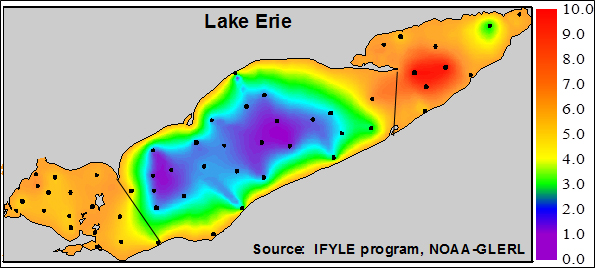Lake Erie hypoxic zone doesnt affect all fish the same, study finds
By Brian Wallheimer, ScienceBlog.com10 January 2011

This image show interpolated bottom water oxygen concentrations in Lake Erie during September 2005. (Image by Stuart Ludsin) http://news.uns.purdue.edu/images/2011/hook-hypoxia.jpg
WEST LAFAYETTE, Ind. – Large hypoxic zones low in oxygen long have been thought to have negative influences on aquatic life, but a Purdue University study shows that while these so-called dead zones have an adverse affect, not all species are impacted equally.
Tomas Höök, an assistant professor of forestry and natural resources, and former Purdue postdoctoral researcher Kristen Arend used output from a model to estimate how much dissolved oxygen was present in Lake Erie’s hypoxic zone each day from 1987 to 2005. That information was compared with biological information for four fish species to assess the hypoxic zone’s impact on the sustainability of their habitats.
“The term ‘dead zone’ sounds really scary,” Höök said. “But in a lot of cases a hypoxic zone will not be negative for all fish species.”
Lake Erie’s hypoxic zone is very large – about the size of Rhode Island and Delaware combined. And while the Gulf of Mexico’s dead zone has received more attention, during some years Lake Erie’s zone may be greater in volume.
Hypoxia occurs when water has less than two parts per million of dissolved oxygen. Discharge of nutrients, such as nitrogen and phosphorus, leads to excess algae growth. When that algae settles to the bottom and decomposes, oxygen is consumed.
The team’s findings, published in the Journal of Freshwater Biology, showed that hypoxia negatively affected habitat quality for all species, but to varying degrees. Yellow perch, for example, saw little decrease, while round goby and rainbow smelt were more significantly affected.
Despite a more positive outlook for habitats of some species, Höök said it’s still unclear how the organisms themselves were affected.
“Invertebrates that are stuck on the bottom of the lake and can’t tolerate a lack of oxygen will die,” Höök said. “But other organisms may be able to tolerate lower levels of oxygen, move up in the water column or even benefit from increased algae growth, which could lead to more invertebrate prey for fish.”
Höök used observed climatic conditions and U.S. Environmental Protection Agency data to estimate daily temperatures and oxygen levels at varying depths over 18 years. Then, researchers used bioenergetic models, which use data about each species’ needs in order to survive, to determine when and at what depth fish species’ habitats were affected by hypoxia.
Höök said more work is needed to understand the organisms’ responses to changes in habitat quality. His research group is developing more complex models to see how hypoxia-induced movements by fish may affect predator-prey relationships and other issues related to hypoxia.
The U.S. National Oceanic and Atmospheric Administration’s Center of Sponsored Coastal Ocean Research funded the research. Höök collaborated with researchers from Lake Superior State University, University of Michigan, Ohio State University, Colorado State University and the NOAA Great Lakes Environmental Research Laboratory.
Writer: Brian Wallheimer, 765-496-2050, bwallhei@purdue.edu
Source: Tomas Höök, 765-496-6799, thook@purdue.edu
Abstract on the research in this release is available at:http://www.purdue.edu/newsroom/research/2011/110110HookHypoxia.html
